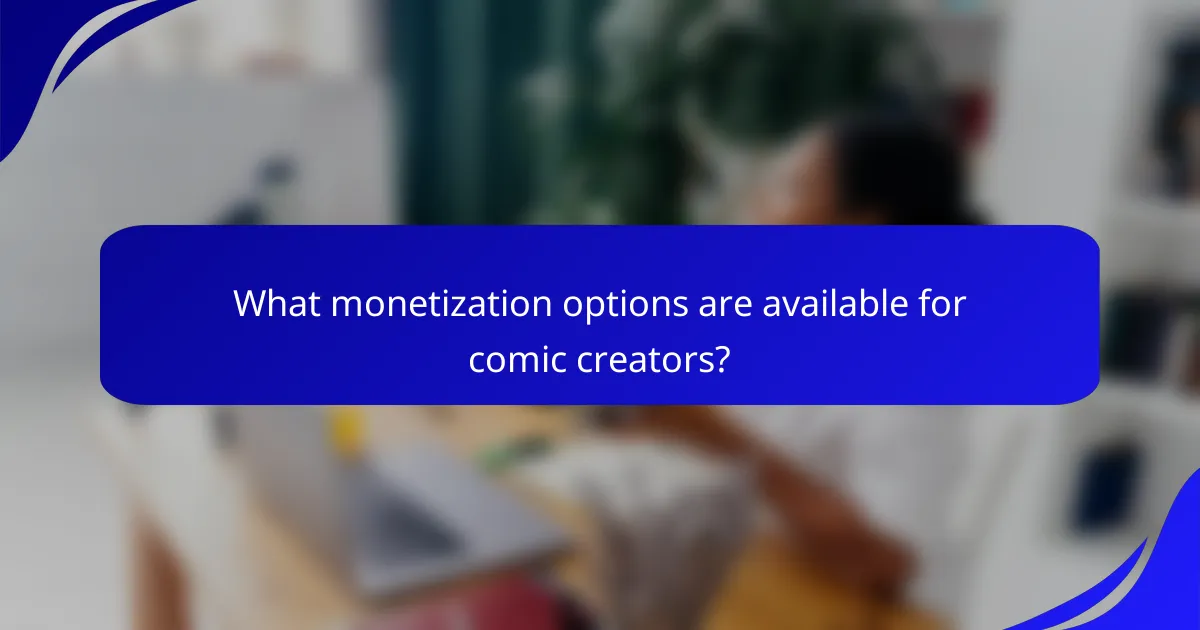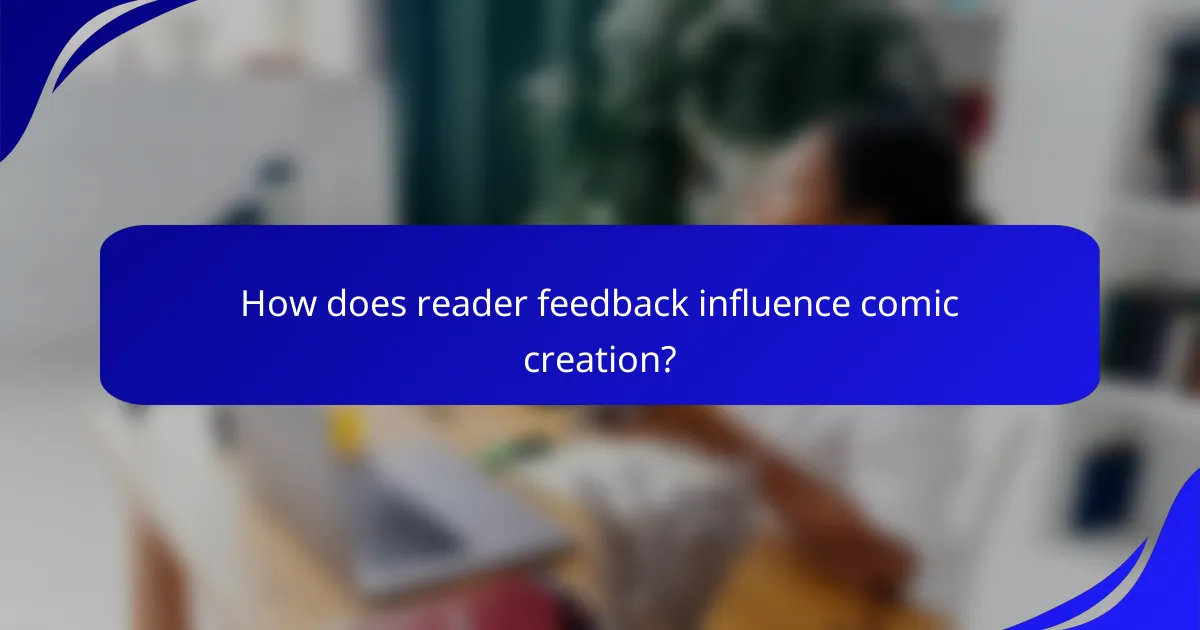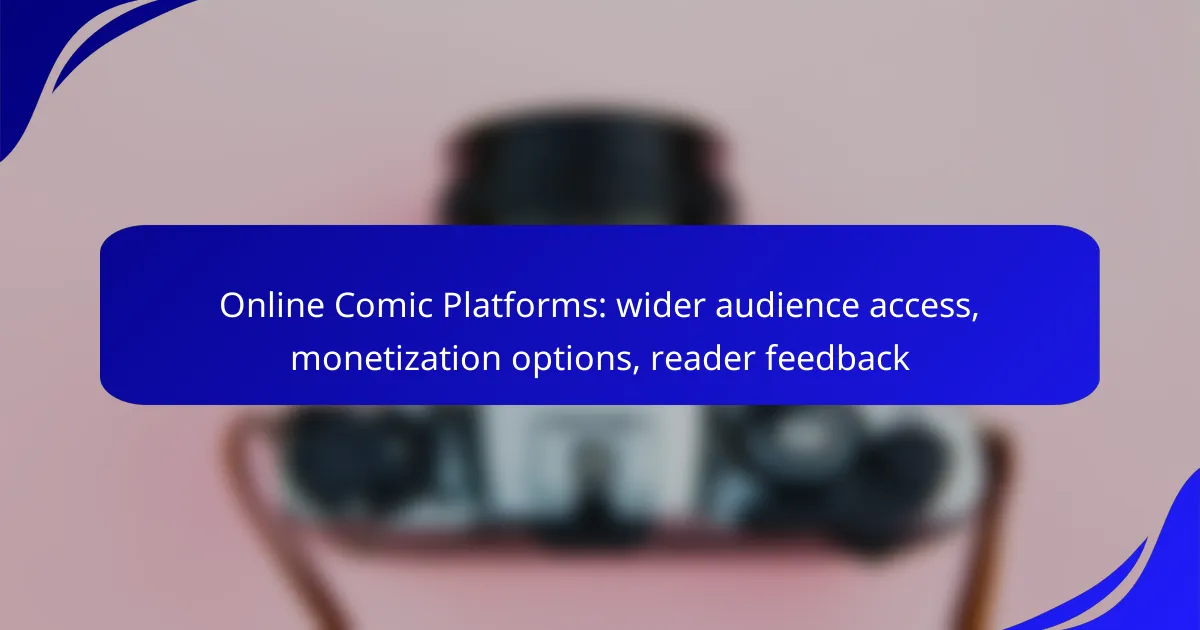Online comic platforms offer creators the opportunity to reach a wider audience through digital distribution and social media integration, while also catering to diverse reader needs with multilingual and accessibility features. Additionally, these platforms provide various monetization options, such as ad revenue and subscription models, enabling creators to earn income from their work. Furthermore, reader feedback is invaluable in guiding creators to refine their storytelling and art, ensuring that their content resonates with audiences.

How can online comic platforms increase audience access?
Online comic platforms can significantly enhance audience access by utilizing digital distribution channels, integrating social media, offering multilingual options, and implementing accessibility features. These strategies enable creators to reach a broader audience and cater to diverse reader needs.
Global distribution through web and mobile
Global distribution allows comics to be available on various devices, including smartphones, tablets, and computers. This accessibility means readers from different regions can easily access content anytime and anywhere, breaking geographical barriers.
Platforms should ensure their websites and apps are optimized for different screen sizes and operating systems. This could involve responsive design and compatibility with both iOS and Android devices to maximize reach.
Social media integration for wider reach
Integrating social media into comic platforms can amplify visibility and engagement. By allowing readers to share their favorite comics on platforms like Facebook, Twitter, and Instagram, creators can tap into existing networks and attract new audiences.
Creators should consider implementing share buttons and promotional campaigns on social media to encourage user-generated content. Engaging with followers through comments and posts can also foster a community around the comics.
Multilingual support for diverse readers
Offering multilingual support is essential for reaching a global audience. By providing translations of comics in various languages, platforms can cater to readers from different linguistic backgrounds, enhancing their reading experience.
Creators should prioritize popular languages based on their target demographics and consider using professional translation services to ensure quality. This approach can help increase readership and foster inclusivity.
Accessibility features for disabled users
Accessibility features are crucial for ensuring that comics are available to users with disabilities. Implementing options like text-to-speech, adjustable font sizes, and high-contrast modes can make content more accessible to a wider audience.
Platforms should adhere to established accessibility standards, such as the Web Content Accessibility Guidelines (WCAG), to ensure compliance. Regular user feedback can help identify areas for improvement and enhance the overall user experience for disabled readers.

What monetization options are available for comic creators?
Comic creators have several monetization options to choose from, allowing them to earn income while sharing their work. These options include ad revenue, subscription models, merchandising, and digital sales, each with its own advantages and considerations.
Ad revenue through Google AdSense
Ad revenue can be generated by integrating Google AdSense into your comic website or blog. This program allows creators to earn money by displaying ads relevant to their audience, with earnings based on clicks or impressions.
To maximize earnings, focus on creating engaging content that attracts traffic. Ensure your site complies with AdSense policies, as violations can lead to account suspension. Regularly monitor performance metrics to optimize ad placements.
Subscription models like Patreon
Subscription models, such as Patreon, enable creators to receive recurring payments from fans in exchange for exclusive content. This can include early access to comics, behind-the-scenes material, or special merchandise.
When setting up a Patreon, consider offering tiered subscription levels to cater to different budgets. Engage with your subscribers regularly to build a community and encourage ongoing support. Be transparent about how funds will be used to enhance your work.
Merchandising through platforms like Etsy
Merchandising allows comic creators to sell physical products related to their work, such as prints, apparel, or collectibles. Platforms like Etsy provide a user-friendly marketplace to reach potential buyers.
To succeed in merchandising, focus on high-quality products that resonate with your audience. Promote your merchandise through social media and your comic platform. Keep an eye on production costs to ensure profitability while pricing items competitively.
Digital sales via ComiXology
Digital sales through platforms like ComiXology enable creators to sell their comics directly to readers. This platform specializes in digital comics and provides a wide audience reach, making it easier to distribute your work.
When publishing on ComiXology, ensure your comic meets their formatting guidelines. Consider promotional strategies, such as discounts or bundles, to attract new readers. Keep track of sales data to understand your audience’s preferences and adjust your offerings accordingly.

How does reader feedback influence comic creation?
Reader feedback plays a crucial role in shaping comic creation by providing insights into audience preferences and engagement. This information helps creators adjust their storytelling, art style, and overall content to better meet the desires of their readers.
Surveys and polls for audience preferences
Surveys and polls are effective tools for gathering reader preferences directly. Creators can use platforms like Google Forms or social media to ask specific questions about characters, plot directions, or art styles. This feedback can guide future story arcs or character developments.
When designing surveys, keep questions clear and concise. Aim for a mix of multiple-choice and open-ended questions to capture both quantitative and qualitative data. For example, asking readers to rank their favorite characters can provide actionable insights.
Comment sections for direct reader interaction
Comment sections allow for real-time interaction between creators and their audience. Readers can share their thoughts, reactions, and suggestions directly under each comic, fostering a sense of community. This immediate feedback can highlight what resonates with the audience and what doesn’t.
To maximize the effectiveness of comment sections, creators should actively engage with readers by responding to comments and asking follow-up questions. This interaction can deepen reader investment and encourage more feedback in the future.
Analytics tools to track engagement
Analytics tools provide valuable data on how readers interact with comics. Platforms like Google Analytics can track metrics such as page views, time spent on each comic, and reader demographics. This information helps creators understand which comics are most popular and why.
When using analytics, focus on key performance indicators (KPIs) such as engagement rates and bounce rates. Regularly reviewing this data can reveal trends over time, allowing creators to adjust their content strategy accordingly. For instance, if a particular genre consistently attracts more readers, it may be worth exploring that theme further.

What are the key features to consider when choosing an online comic platform?
When selecting an online comic platform, prioritize user-friendly interfaces, monetization options, and community engagement features. These elements significantly impact both creator experience and audience interaction.
User-friendly interface for creators
A user-friendly interface is essential for creators to efficiently upload and manage their comics. Look for platforms that offer intuitive navigation, drag-and-drop functionality, and easy formatting tools. This can save time and reduce frustration, allowing artists to focus on their work.
Consider platforms that provide templates or customizable layouts to enhance the visual appeal of your comics. A clean design can attract more readers and improve overall engagement.
Built-in monetization tools
Monetization options are crucial for creators looking to earn from their work. Platforms may offer various tools such as subscription models, pay-per-view, or ad revenue sharing. Evaluate which model aligns best with your audience and content style.
Some platforms allow creators to set their prices or offer tiered memberships, giving flexibility in how you monetize your comics. Research the fee structures and payout schedules to ensure they are favorable for your financial goals.
Community engagement features
Community engagement features foster interaction between creators and readers, enhancing the overall experience. Look for platforms that include comment sections, forums, or social media integration to facilitate discussions around your comics.
Engagement tools such as polls or feedback forms can help creators understand audience preferences and improve future content. A strong community can lead to increased loyalty and support for your work.

How do online comic platforms compare in terms of audience engagement?
Online comic platforms vary significantly in audience engagement, with factors like user interaction, content sharing, and community involvement playing crucial roles. Platforms that prioritize reader feedback and offer monetization options tend to foster a more engaged user base.
Platform A vs Platform B engagement metrics
Platform A typically sees higher engagement metrics than Platform B, with average reading times often exceeding single-digit minutes per session. User comments and shares are also more frequent on Platform A, indicating a more active community.
In terms of monetization, Platform A offers various options like tipping and subscription models, which can enhance user investment in the content. Platform B, while having fewer monetization avenues, may appeal to creators looking for a straightforward publishing experience.
Success stories from Webtoon and Tapas
Webtoon has successfully engaged millions of readers by implementing a user-friendly interface and interactive features like comment sections and community challenges. This approach has led to several creators achieving significant financial success through ad revenue and reader donations.
Tapas, on the other hand, has carved out a niche by focusing on serialized storytelling and offering a unique tipping system. Many creators on Tapas have reported building loyal followings, which translates to consistent income through reader support and merchandise sales.

What emerging trends are shaping the future of online comic platforms?
Emerging trends in online comic platforms are significantly enhancing audience engagement and monetization strategies. Key developments include the rise of augmented reality comics and the increased use of artificial intelligence in comic creation, both of which are transforming how creators connect with readers.
Rise of augmented reality comics
Augmented reality (AR) comics are gaining traction as they offer immersive experiences that blend digital content with the physical world. Readers can use their smartphones or AR glasses to interact with comic panels, bringing characters and scenes to life through animations and sound effects.
This trend allows creators to explore innovative storytelling techniques and engage audiences in new ways. For example, a comic might include a QR code that, when scanned, reveals additional content or animations, enhancing the overall narrative experience.
Increased use of AI in comic creation
The integration of artificial intelligence in comic creation is streamlining the production process and enabling new artistic possibilities. AI tools can assist artists by generating backgrounds, suggesting character designs, or even writing dialogue, which can significantly reduce the time spent on each project.
While AI can enhance creativity, it is essential for creators to maintain their unique voice and style. Balancing AI assistance with personal artistry ensures that the final product resonates with readers while benefiting from technological advancements.
